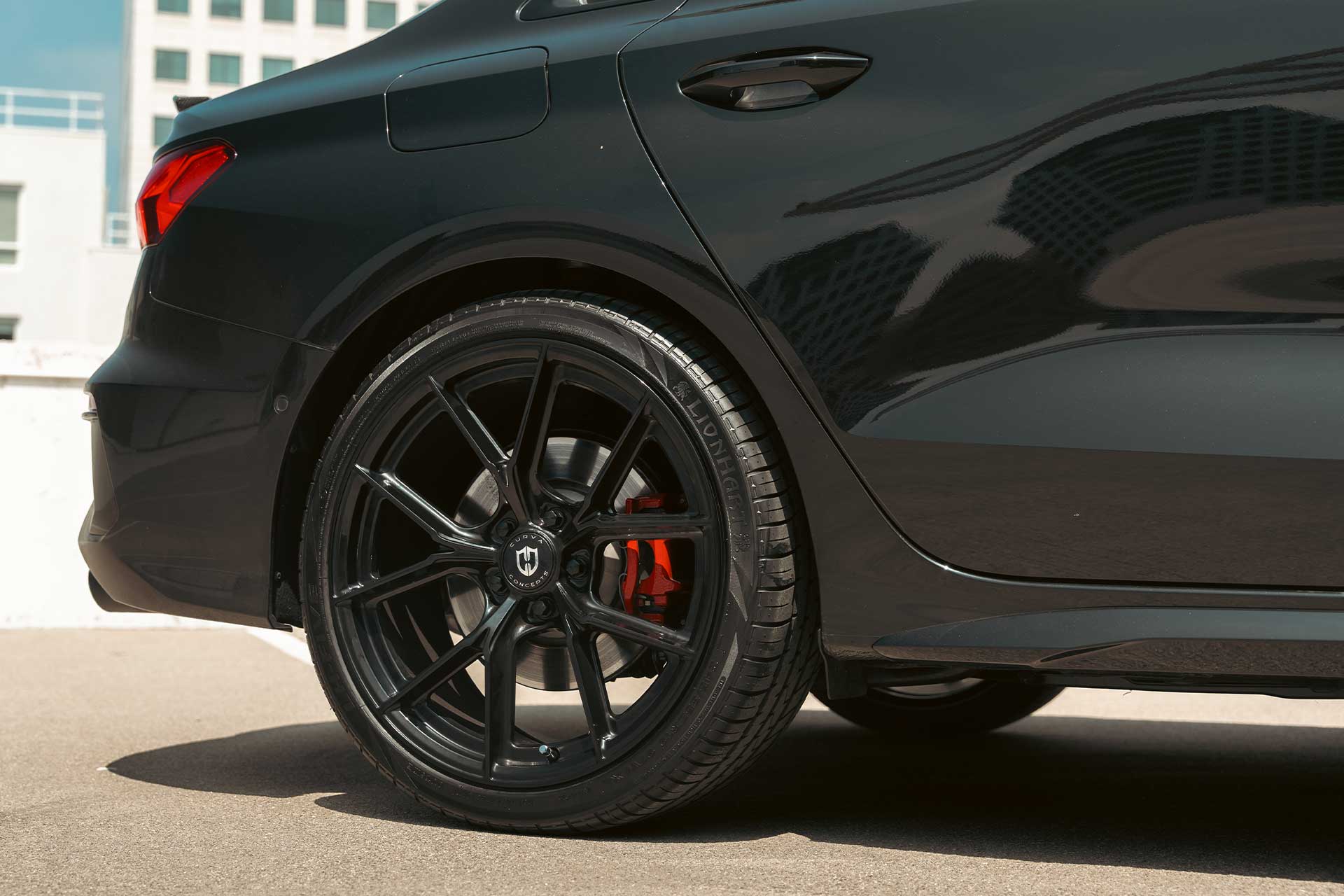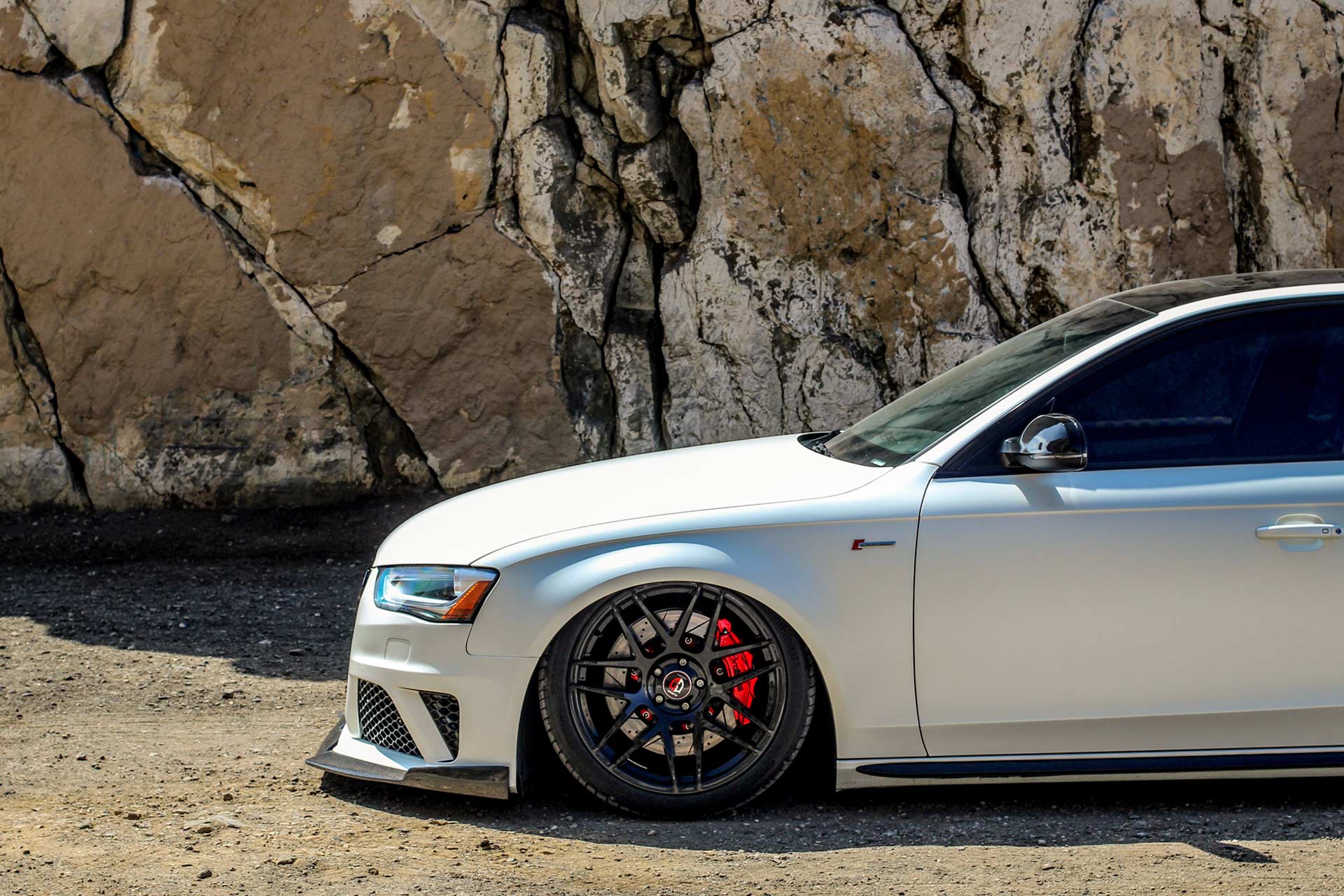Wheel Fitment Research For Dummies
Ordering wheels blindly because you saw someone else’s sick setup on Instagram ranks high on the list of expensive mistakes. Return shipping and restocking fees alone can run you hundreds of dollars, and that’s assuming they even accept returns in the first place. What’s worse, is that some people come across these fitment issues only after mounting and driving.
The good news? Doing wheel fitment research takes 30 minutes to an hour tops, and it eliminates nearly all of these headaches. In this guide, we’ll walk you through a proven three-step verification process that thousands of enthusiasts use by hitting the “add to cart” button. Follow this workflow, and you’ll get to brag about who got their fitment right the first time.
Step 1: The Baseline – OEM Specs and Proven Setups
Find Your Factory Wheel Specifications
Your researching journey starts with understanding what came on your car from the factory. Check your driver’s door jamb sticker or flip through your owner’s manual to find the OEM wheel specs. These documents list diameter, width, offset, bolt pattern (PCD), and hub bore size.
If you’re too lazy to do that; don’t worry, there’s an easier way to find this information. Check Wheel-Size.com and search your year, make, model, and trim. This database compiles factory specifications across virtually every vehicle sold globally, saving you from digging through glove box papers and using your phone’s flashlight at 11:34 PM on a Tuesday night.
Document these numbers in your phone’s notes app or a simple spreadsheet. You’ll reference them repeatedly throughout your research.
Browse Verified Fitments
The OEM wheel specs establish a solid baseline, but real-world examples show what actually works. Search Instagram, YouTube or TikTok using your exact year (generation/chassis code works too), make, model and trim. Be sure to include keywords like “wheel fitment,” “wheels,” or “setup” to narrow down results.
If you’re more involved in your cars community, dedicated vehicle-specific forums offer even more detailed information. Nearly every popular platform has a dedicated online community where owners document their builds with exact specifications. Some of these forums even have dedicated wheel and tire fitment threads. Look for posts that include offset, width, bolt pattern and diameter measurements.
Our own vehicle gallery and fitment guides showcase confirmed setups across popular platforms. These resources compile builds we’ve verified and tested personally, eliminating guesswork.
The Safe Zone
Create a list of confirmed fitments on that spreadsheet or notes we talked about earlier. Note which setups bolt on directly versus those that need fender modifications, camber adjustments or suspension changes.
DO NOT FORGET ABOUT TIRE SIZES
Aspect ratio and section width play a major role in fitment, affecting clearance, especially on cars lowered with coilovers, springs or air suspension.
The goal isn’t necessarily finding the most aggressive fitment. You’re simply cross-referencing what’s been proven to work with success on other people’s builds. However, if you are going for an aggressive setup, you’ll have to accept the fact that you may need more negative camber and fender rolling/shaving. You gotta pay to play.

Step 2: Real-World Compatibility
Brake Clearance
Not all wheels are created equal. A wheel with identical sizing but different spoke designs can fit much differently from each other. Why? Because brake calipers come in all shapes and sizes depending on your car. The spokes of the wheel need to clear the calipers with enough room to spare.
Pro-Tip: Tight clearances are okay, but make sure your car isn’t equipped with floating rotors, since these naturally have play in them.
Low spoke count wheels, like a classic 5 spoke, offer better brake clearance versus multi-spoke designs, though manufacturing advancements and offset optimization has narrowed this gap significantly. If you’re planning on running bigger aftermarket brakes, prioritize wheels that others have confirmed to fit with similar setups.
Understanding brake compatibility saves you from mounting a set of wheels that make contact with your calipers, rendering your car undriveable. If you want to dive deeper into wheel specs that affect brake clearance and performance, check out our guide on understanding wheel specifications beyond basic fitment.
Tire Size Verification
Like we mentioned earlier, take note of the tire sizes that pair with your target wheel specifications. The same forums also cover which aspect ratio and section width combinations avoid rubbing during compression and steering lock. Trust us, every millimeter counts.
Another important thing to note is that not all tires are the same, even if they are the same size. That’s confusing, we know. But a 285 from Michelin runs wider than a 285 from Lexani. Keep that in mind when shopping for tires.
In the end if the ideal fitment calls for a 255/35R19 on 19×9.5 ET35 wheels, that’s data worth respecting.

Step 3: The Home Stretch – Final Verification
Use a Wheel Fitment Calculator
Once you’ve boiled it down to one or two fitments, drop that information into our wheel fitment calculator along with your OEM specs. This tool is designed to show changes to poke, inset, offset, and overall wheel diameter.
Whether your planned setup stays within acceptable ranges or pushes into modification territory, this calculator will give you the raw numbers you need to know. Even a few millimeters of added poke could require slight fender rolling, while super excessive changes could result in fender shaving.
Pay close attention to offset changes, a critical specification that determines how the wheel positions relative to your suspension and fender. Our detailed breakdown of offset optimization explains how this measurement affects both aesthetics and performance.
Physical Measurements
Ready to get technical? If you want to really make sure your new wheels will fit, grab a tape measure and ruler for direct measurements of your vehicle. Or if you have the money, you can use a wheel fitment tool. Don’t worry, that’s not a sponsored link.
If you’re going the traditional route, measure the distance from fender lip to hub face. This number, combined with your offset and wheel width will determine final fitment. To be even more sure, check suspension travel by compressing the suspension manually while watching clearance between tire and fender. Turn the steering wheel to full lock and assess clearance during maximum articulation.
If you’re not planning on staying at stock height and looking at coils, springs or air, then account for your lowest expected ride height when measuring. Wheels that fit at stock height will probably rub when slammed. All wheels, including our Flow Forged wheels are engineered for strength and weight savings, but they still need proper clearance to perform their best.
Measure your brake caliper depth with a caliper tool or ruler. Compare this dimension against published brake clearance specs for wheels you’re considering.

Pre-Purchase Checklist
Before clicking order, verify these critical specifications:
- Bolt pattern match – Must be exact
- Hub bore compatibility – Confirm hub rings if needed (see our hub-centric vs lug-centric wheels guide)
- TPMS valve compatibility – Ensure sensors transfer or new valves accommodate existing sensors
- Lug seat type verification – Conical, ball, or flat seat must match your wheels (detailed in our wheel hardware and lug seat types guide)
These fundamentals prevent common mistakes that derail builds before they start. Speaking of mistakes, our article on 6 common wheel buying mistakes to avoid covers additional pitfalls worth reviewing.
Pre‑Purchase Wheel Fitment Checklist
Verify these four items before ordering to avoid returns and install surprises.
| Checklist item | What to verify | Notes | Done |
|---|---|---|---|
|
01
Bolt pattern (PCD)
More infoMatch stud count and PCD exactly (e.g., 5×114.3), confirmed against your OEM baseline and vehicle documentation. |
Exact stud count and diameter match to vehicle specification; avoid adapters unless planned and documented. | ||
|
02
Hub bore compatibility
More infoConfirm the wheel’s center bore equals the vehicle hub for hub‑centric fit, or plan correct hub‑centric rings if the bore is larger. |
Wheel center bore equals hub size, or proper rings sourced; reject undersized bores and ensure vibration‑free, centered mounting. | ||
|
03
TPMS valve compatibility
More infoConfirm sensor type and valve interface, and plan new seals/grommets if transferring sensors to the new wheels. |
Sensor type and frequency supported; valve stem fit and seal kit ready for install or replacement sensors sourced as needed. | ||
|
04
Lug seat type match
More infoMatch seat profile and angle to wheel spec (e.g., conical 60°, ball R13/R14, or mag/shank); never mix seat types. |
Wheel seat profile and hardware seat/angle confirmed; correct nuts or bolts on hand for installation torque spec. |
Extreme Builds Require Modifications
The guidelines above provide safe, proven fitment territory for enthusiasts looking for aggressive yet functional setups. Extreme builds like VIP, Hellaflush and Stanced almost always will require fender mods, bumper adjustments, suspension geometry changes, and substantial camber. These specialized applications fall outside of basic fitment parameters and require experienced people who understand the tradeoffs.

Quick Reference: Red Flags to Avoid
Certain warning signs should be a dead giveaway:
Setups with zero documentation – If nobody’s running it, there’s probably a reason.
Extreme offset changes without modification notes – Claims of fitting a ET10 offset on a car that runs ET45 stock. Yeah, okay buddy.
Conflicting information across multiple sources – When data contradicts each other, dig deeper before committing.
The 80/20 Rule of Fitment Research
Following proven fitments from verified sources eliminates 80% of fitment risk. You’re building on the collective experience of thousands who’ve already tested these combinations. The remaining 20% comes down to your specific vehicle’s condition, any existing modifications, and your tolerance for minor adjustments.
Most really good builds don’t push the boundaries of wheel fitment, they choose the right set of wheels that’ll fit. Save the science experiments for builds you’re prepared to invest into.
If you’ve done all of the research outlined above, and you’re still on the fence about which fitment to go with, give us a call or contact us and our fitment experts will help get you set up.
That 30-60 minutes you spend upfront can translate to thousands of dollars saved and months of headaches and frustrations. Start with your OE specs, and build up from that through the various, proven techniques we talked about. This approach almost guarantees you’ll find a wheel and tire fitment that’s on the money. Remember…measure twice, cut once.

